Analysis of Solid Waste Treatment and Management in Typical Chinese Industrial Parks with the Goal of Sustainable Development and Future Suggestions
Abstract
1. Introduction
2. Materials and Methods
2.1. Solid Waste Disposal Technology of Landfill
2.2. Solid Waste Disposal Technology of Incineration
2.3. Solid Waste Biological Disposal Technology
2.4. Network Analysis Method
3. Results and Discussion
3.1. The Demonstration Park of Multi-Source Solid Waste Disposal and Management
3.2. Solid Waste Management in Typical Industrial Parks of China
3.2.1. Multi-Source Solid Waste Collaborative Disposal Parks in Small–Medium Cities
3.2.2. Multi-Source Solid Waste Collaborative Disposal Parks in Large–Medium Cities
3.2.3. Solid Waste Disposal and Resource Recycling Industrial Parks in Megacities
3.3. Suggestions for Industrial Park Sustainable Development
3.4. Advancement of China’s Solid Waste Industry Development
4. Conclusions and Prospect
Supplementary Materials
Author Contributions
Funding
Institutional Review Board Statement
Informed Consent Statement
Data Availability Statement
Acknowledgments
Conflicts of Interest
References
- Rossit, D.G.; Nesmachnow, S. Waste bins location problem: A review of recent advances in the storage stage of the Municipal Solid Waste reverse logistic chain. J. Clean. Prod. 2022, 342, 130793. [Google Scholar] [CrossRef]
- Rodygin, K.S.; Lotsman, K.A.; Samoylenko, D.E.; Kuznetsov, V.M.; Ananikov, V.P. Towards Sustainable Carbon Return from Waste to Industry via C2-Type Molecular Unit. Int. J. Mol. Sci. 2022, 23, 11828. [Google Scholar] [CrossRef]
- Ministry of Ecology and Environment of the People’s Republic of China, Regulations on the Administration of Medical Wastes. Available online: https://www.ajne.org/sites/default/files/document/laws/6874/regulations-on-the-administration-of-medical-wastes.pdf (accessed on 31 July 2024).
- Ye, M.; Liang, X.; Lin, S.; Lin, H.; Deng, F. Efficiency Assessment of Hazardous Waste Disposal in EU Countries: A Three-Stage Super-Efficiency Data Envelopment Analysis Model. Environ. Manag. 2022, 70, 650–665. [Google Scholar] [CrossRef]
- Ministry of Ecology and Environment of the People’s Republic of China, Annual Report on the Prevention and Control of Environmental Pollution by Solid Waste in Large and Medium Cities in 2020. Available online: https://www.mee.gov.cn/ywgz/gtfwyhxpgl/gtfw/202012/P020201228557295103367.pdf (accessed on 31 July 2024).
- Ministry of Ecology and Environment of the People’s Republic of China, Annual Report of China Ecological and Environmental Statistics 2021. Available online: https://www.mee.gov.cn/hjzl/sthjzk/sthjtjnb/202301/t20230118_1013682.shtml (accessed on 31 July 2024).
- World Bank Group. What a Waste 2.0: A Global Snapshot of Solid Waste Management to 2050 (English). Available online: https://documents1.worldbank.org/curated/en/697271544470229584/pdf/What-a-Waste-2-0-A-Global-Snapshot-of-Solid-Waste-Management-to-2050.pdf (accessed on 31 July 2024).
- Anand, N.; Palani, S.G. A comprehensive investigation of toxicity and pollution potential of municipal solid waste landfill leachate. Sci. Total Environ. 2022, 838, 155891. [Google Scholar] [CrossRef]
- Weligama, T.R.; Babel, S. Assessment of the environmental sustainability of municipal solid waste valorization by anaerobic digestion and by composting in Sri Lanka. Environ. Technol. 2022, 1–14. [Google Scholar] [CrossRef]
- Hubai, K.; Kováts, N.; Sainnokhoi, T.A.; Eck-Varanka, B.; Hoffer, A.; Tóth, Á.; Teke, G. Phytotoxicity of particulate matter from controlled burning of different plastic waste types. Bull. Environ. Contam. Toxicol. 2022, 109, 852–858. [Google Scholar] [CrossRef] [PubMed]
- Namoun, A.; Tufail, A.; Khan, M.Y.; Alrehaili, A.; Syed, T.A.; BenRhouma, O. Solid Waste Generation and Disposal Using Machine Learning Approaches: A Survey of Solutions and Challenges. Sustainability 2022, 14, 13578. [Google Scholar] [CrossRef]
- Ma, R.; Wang, J.; Liu, Y.; Wang, G.; Yang, Y.; Liu, Y.; Kong, Y.; Lin, J.; Li, Q.; Li, G.; et al. Dynamics of antibiotic resistance genes and bacterial community during pig manure, kitchen waste, and sewage sludge composting. J. Environ. Manag. 2023, 345, 118651. [Google Scholar] [CrossRef]
- Liu, Y.; Zhang, Y.; Wang, M.; Wang, L.; Zheng, W.; Zeng, Q.; Wang, K. Comparison of the basic processes of aerobic, anaerobic, and aerobic-anaerobic coupling composting of Chinese medicinal herbal residues. Bioresour. Technol. 2023, 379, 128996. [Google Scholar] [CrossRef] [PubMed]
- Al-Balushi, F.; Ibrahim, O.; Rajamohan, N. Sustainable treatment of landfill leachate: A review on methods. Int. J. Environ. Sci. Technol. 2024. [Google Scholar] [CrossRef]
- Guo, W.; Xi, B.; Huang, C.; Li, J.; Tang, Z.; Li, W.; Ma, C.; Wu, W. Solid waste management in China: Policy and driving factors in 2004–2019. Resour. Conserv. Recycl. 2021, 173, 105727. [Google Scholar] [CrossRef]
- Abdel-Shafy, H.I.; Mansour, M.S. Solid waste issue: Sources, composition, disposal, recycling, and valorization. Egypt. J. Pet. 2018, 27, 1275–1290. [Google Scholar] [CrossRef]
- Gu, B.; Tang, X.; Liu, L.; Li, Y.; Fujiwara, T.; Sun, H.; Gu, A.; Yao, Y.; Duan, R.; Song, J.; et al. The recyclable waste recycling potential towards zero waste cities—A comparison of three cities in China. J. Clean. Prod. 2021, 295, 126358. [Google Scholar] [CrossRef]
- Zhu, Z.; Zhao, Y.; Zhu, Y.; Zhang, M.; Yu, Y.; Guo, Y.; Zhou, T. Efficient treatment of mature landfill leachate with a novel composite biological trickle reactor developed using refractory domestic waste and aged refuse. J. Clean. Prod. 2021, 305, 127194. [Google Scholar] [CrossRef]
- Ma, S.; Zhou, C.; Pan, J.; Yang, G.; Sun, C.; Liu, Y.; Chen, X.; Zhao, Z. Leachate from municipal solid waste landfills in a global perspective: Characteristics, influential factors and environmental risks. J. Clean. Prod. 2022, 333, 130234. [Google Scholar] [CrossRef]
- Bolan, N.; Hoang, S.A.; Tanveer, M.; Wang, L.; Bolan, S.; Sooriyakumar, P.; Robinson, B.; Wijesekara, H.; Wijesooriya, M.; Keerthanan, S.; et al. From mine to mind and mobiles—Lithium contamination and its risk management. Environ. Pollut. 2021, 290, 118067. [Google Scholar] [CrossRef] [PubMed]
- Lipczynska-Kochany, E. Effect of climate change on humic substances and associated impacts on the quality of surface water and groundwater: A review. Sci. Total Environ. 2018, 640–641, 1548–1565. [Google Scholar] [CrossRef] [PubMed]
- Huang, X.; Wei, X.; Liu, H.; Li, W.; Shi, D.; Qian, S.; Sun, W.; Yue, D.; Wang, X. Occurrence of per- and polyfluoroalkyl substances (PFAS) in municipal solid waste landfill leachates from western China. Environ. Sci. Pollut. Res. 2022, 29, 69588–69598. [Google Scholar] [CrossRef] [PubMed]
- Ruan, X.; Wang, H.; Luo, Y.S.; Hou, C. Composite Failure Analysis of Municipal Solid Waste Landfill Cell Stability. Iran. J. Sci. Technol. Trans. Civ. Eng. 2022, 46, 2325–2343. [Google Scholar] [CrossRef]
- Istrate, I.R.; Galvez-Martos, J.L.; Vázquez, D.; Guillén-Gosálbez, G.; Dufour, J. Prospective analysis of the optimal capacity, economics and carbon footprint of energy recovery from municipal solid waste incineration. Resour. Conserv. Recycl. 2023, 193, 106943. [Google Scholar] [CrossRef]
- Wu, Q.; Wu, Z.; Wu, H.; Wang, Q.; Huang, N.; Zhou, J.; Li, X.; Shi, L.; Tian, S.; Li, M. Thermal treatment of municipal solid waste incineration fly ash and nanofiltration membrane concentrate co-processing: Speciation of chromium and its leachability. J. Clean. Prod. 2023, 398, 136619. [Google Scholar] [CrossRef]
- Xiao, W.; Liu, T.; Tong, X. Assessing the carbon reduction potential of municipal solid waste management transition: Effects of incineration, technology and sorting in Chinese cities. Resour. Conserv. Recycl. 2023, 188, 106713. [Google Scholar] [CrossRef]
- Han, X.; Chang, H.; Wang, C.; Tai, J.; Karellas, S.; Yan, J.; Song, L.; Bi, Z. Tracking the life-cycle greenhouse gas emissions of municipal solid waste incineration power plant: A case study in Shanghai. J. Clean. Prod. 2023, 398, 136635. [Google Scholar] [CrossRef]
- Wei, J.; Li, H.; Liu, J.; Zhong, R. National and provincial dioxin emissions from municipal solid waste incineration in China. Sci. Total Environ. 2022, 851, 158128. [Google Scholar] [CrossRef] [PubMed]
- Sorrentino, G.P.; Zanoletti, A.; Ducoli, S.; Zacco, A.; Iora, P.; Invernizzi, C.M.; Di Marcoberardino, G.; Depero, L.E.; Bontempi, E. Accelerated and natural carbonation of a municipal solid waste incineration (MSWI) fly ash mixture: Basic strategies for higher carbon dioxide sequestration and reliable mass quantification. Environ. Res. 2023, 217, 114805. [Google Scholar] [CrossRef]
- Niu, Y.; Wen, L.; Guo, X. Co-disposal and reutilization of municipal solid waste and its hazardous incineration fly ash. Environ. Int. 2022, 166, 107346. [Google Scholar] [CrossRef] [PubMed]
- Arunthathi, S.; Sivapriya, S.V.; Balaji, D. Assessing the compaction characteristics of modified soil with Incinerated municipal solid waste. Mater. Today Proc. 2022, 62, 629–632. [Google Scholar] [CrossRef]
- Li, Y.; Jiang, X.; Lv, G.; Chen, Q.; Liu, X.; Yan, J.; Zhao, X.; Kong, L. Research on mechanism and effect of phosphorus-containing wastewater treatment by municipal solid waste incineration fly ash. Int. J. Environ. Sci. Technol. 2023, 20, 6479–6490. [Google Scholar] [CrossRef]
- Nguyen, T.H.; Pham, Q.V.; Nguyen, T.P.; Vu, V.T.; Do, T.H.; Hoang, M.T.; Thu Thuy Thi, N.; Minh, T.B. Distribution characteristics and ecological risks of heavy metals in bottom ash, fly ash, and particulate matter released from municipal solid waste incinerators in northern Vietnam. Environ. Geochem. Health 2022, 45, 2579–2590. [Google Scholar] [CrossRef]
- Salehiyoun, A.R.; Zilouei, H.; Safari, M.; Di Maria, F.; Samadi, S.H.; Norouzi, O. An investigation for improving dry anaerobic digestion of municipal solid wastes by adding biochar derived from gasification of wood pellets. Renew. Energy 2022, 186, 1–9. [Google Scholar] [CrossRef]
- Manikandan, S.; Vickram, S.; Sirohi, R.; Subbaiya, R.; Krishnan, R.Y.; Karmegam, N.; Sumathijones, C.; Rajagopal, R.; Chang, S.W.; Ravindran, B.; et al. Critical review of biochemical pathways to transformation of waste and biomass into bioenergy. Bioresour. Technol. 2023, 372, 128679. [Google Scholar] [CrossRef] [PubMed]
- Bernat, K.; Kulikowska, D.; Wojnowska-Baryła, I.; Kamińska, A. Can the biological stage of a mechanical–biological treatment plant that is designed for mixed municipal solid waste be successfully utilized for effective composting of selectively collected biowaste? Waste Manag. 2022, 149, 291–301. [Google Scholar] [CrossRef] [PubMed]
- Saravanan, A.; Kumar, P.S.; Nhung, T.C.; Ramesh, B.; Srinivasan, S.; Rangasamy, G. A review on biological methodologies in municipal solid waste management and landfilling: Resource and energy recovery. Chemosphere 2022, 309, 136630. [Google Scholar] [CrossRef] [PubMed]
- Le Pera, A.; Sellaro, M.; Bencivenni, E.; D’Amico, F. Environmental sustainability of an integrate anaerobic digestion-composting treatment of food waste: Analysis of an Italian plant in the circular bioeconomy strategy. Waste Manag. 2022, 139, 341–351. [Google Scholar] [CrossRef] [PubMed]
- Liang, J.; Luo, L.; Wong, J.W.; He, D. Recent advances in conductive materials amended anaerobic co-digestion of food waste and municipal organic solid waste: Roles, mechanisms, and potential application. Bioresour. Technol. 2022, 360, 127613. [Google Scholar] [CrossRef] [PubMed]
- Mlaik, N.; Karray, F.; Sayadi, S.; Feki, F.; Khoufi, S. Semi-continuous anaerobic digestion of the organic fraction of municipal solid waste: Digester performance and microbial population dynamics. J. Environ. Chem. Eng. 2022, 10, 107941. [Google Scholar] [CrossRef]
- Lei, G.; Guo, S.; Yuan, Z. Study on the Effect and Mechanism of Circular Economy Promotion Law on the Utilization Rate of Industrial Solid Waste in Resource-Based Cities. Sustainability 2022, 14, 9878. [Google Scholar] [CrossRef]
- Ndou, V.; Rampedi, I.T. Bibliometric Analysis of Municipal Solid Waste Management Research: Global and South African Trends. Sustainability 2022, 14, 10229. [Google Scholar] [CrossRef]
- Khan, A.H.; Kiyani, A.; Santiago-Herrera, M.; Ibánez, J.; Yousaf, S.; Iqbal, M.; Martel-Martín, S.; Barros, R. Sustainability of phytoremediation: Post-harvest stratagems and economic opportunities for the produced metals contaminated biomass. J. Environ. Manag. 2023, 326, 116700. [Google Scholar] [CrossRef]
- Ye, Q.; Umer, Q.; Zhou, R.; Asmi, A.; Asmi, F. How publications and patents are contributing to the development of municipal solid waste management: Viewing the UN Sustainable Development Goals as ground zero. J. Environ. Manag. 2023, 325, 116496. [Google Scholar] [CrossRef]
- Ansari, S.A.; Shakeel, A.; Sawarkar, R.; Maddalwar, S.; Khan, D.; Singh, L. Additive facilitated co-composting of lignocellulosic biomass waste, approach towards minimizing greenhouse gas emissions: An up to date review. Environ. Res. 2023, 224, 115529. [Google Scholar] [CrossRef]
- Li, J.; Suvarna, M.; Li, L.; Pan, L.; Pérez-Ramírez, J.; Ok, Y.S.; Wang, X. A review of computational modeling techniques for wet waste valorization: Research trends and future perspectives. J. Clean. Prod. 2022, 367, 133025. [Google Scholar] [CrossRef]
- Mondal, T.; Choudhury, M.; Kundu, D.; Dutta, D.; Samanta, P. Landfill: An eclectic review on structure, reactions and remediation approach. Waste Manag. 2023, 164, 127–142. [Google Scholar] [CrossRef]
- Hurlbert, M.; Bhardwaj, A.; Akbari, M. Best versus beneficial MP discourses: The significance of a change in discourse managing agricultural water quality in Canada. J. Environ. Manag. 2023, 332, 117289. [Google Scholar] [CrossRef]
- Vlachokostas, C.; Achillas, C.; Michailidou, A.V.; Tsegas, G.; Moussiopoulos, N. Externalities of energy sources: The operation of a municipal solid waste-to-energy incineration facility in the greater Thessaloniki area, Greece. Waste Manag. 2020, 113, 351–358. [Google Scholar] [CrossRef]
- Zhao, Y.; Long, B. Study on Human Settlement Environment in Dai Traditional Villages of Different Regions. IOP Conf. Ser. Earth Environ. Sci. 2020, 568, 12035. [Google Scholar] [CrossRef]
- Meng, L.; Huang, J.; Dong, J. Assessment of rural ecosystem health and type classification in Jiangsu province, China. Sci. Total Environ. 2018, 615, 1218–1228. [Google Scholar] [CrossRef]
- Liu, Y.S.; Wang, J.Y.; Long, H.L. Analysis of arable land loss and its impact on rural sustainability in Southern Jiangsu Province of China. J. Environ. Manag. 2010, 91, 646–653. [Google Scholar] [CrossRef]
- Zhao, J.; Li, B.; Wei, X.; Zhang, Y.; Li, T. Slagging characteristics caused by alkali and alkaline earth metals during municipal solid waste and sewage sludge co-incineration. Energy 2020, 202, 117773. [Google Scholar] [CrossRef]
- Chen, C.; Wen, Z.; Wang, Y.; Zhang, W.; Zhang, T. Multi-objective optimization of technology solutions in municipal solid waste treatment system coupled with pollutants cross-media metabolism issues. Sci. Total Environ. 2022, 807, 150664. [Google Scholar] [CrossRef]
- Meng, M.; Wen, Z.; Luo, W.; Wang, S. Approaches and Policies to Promote Zero-Waste City Construction: China’s Practices and Lessons. Sustainability 2021, 13, 13537. [Google Scholar] [CrossRef]
- Li, Z.; Zhang, T.; Sun, Y.; Zheng, L.; Zhou, H.; Wang, H.; Chen, T.; Yan, J. Identifying the key policy drivers for behavioral improvement in waste source separation in the Yangtze Delta Region, China. J. Clean. Prod. 2022, 351, 131379. [Google Scholar] [CrossRef]
- Wen, Z.; Xie, Y.; Chen, C.; Li, Y.; Xu, P. Water-energy-nutrient nexus: Multi-sectoral metabolism analysis and technical path optimization for eco-towns. J. Environ. Manag. 2021, 277, 111395. [Google Scholar] [CrossRef]
- Cheng, M.; Wen, Z.; Yang, S. The driving effect of technological innovation on green development: Dynamic efficiency spatial variation. Environ. Sci. Pollut. Res. 2022, 29, 84562–84580. [Google Scholar] [CrossRef]
- Chen, C.; Wen, Z. Cross-media transfer of nitrogen pollution in the fast-urbanized Greater Bay Area of China: Trends and essential control paths. J. Environ. Manag. 2023, 326, 116796. [Google Scholar] [CrossRef]
- Kosajan, V.; Wen, Z.; Fei, F.; Dinga, C.D.; Wang, Z.; Liu, P. Comprehensive assessment of cement kiln co-processing under MSW sustainable management requirements. Resour. Conserv. Recycl. 2021, 174, 105816. [Google Scholar] [CrossRef]
- Zhang, R.; Tai, H.; Cheng, K.; Zhu, Y.; Hou, J. Carbon emission efficiency network formation mechanism and spatial correlation complexity analysis: Taking the Yangtze River Economic Belt as an example. Sci. Total Environ. 2022, 841, 156719. [Google Scholar] [CrossRef]
- Tian, Y.; Pang, J. The role of internet development on green total-factor productivity—An empirical analysis based on 109 cities in Yangtze River economic belt. J. Clean. Prod. 2022, 378, 134415. [Google Scholar] [CrossRef]
- Zhang, J.; Zhang, P.; Wang, R.; Liu, Y.; Lu, S. Identifying the coupling coordination relationship between urbanization and forest ecological security and its impact mechanism: Case study of the Yangtze River Economic Belt, China. J. Environ. Manag. 2023, 342, 118327. [Google Scholar] [CrossRef]
- Xue, J.; Wang, Q.; Zhang, M. A review of non-point source water pollution modeling for the urban–rural transitional areas of China: Research status and prospect. Sci. Total Environ. 2022, 826, 154146. [Google Scholar] [CrossRef]
- Atanasovska, I.; Choudhary, S.; Koh, L.; Ketikidis, P.H.; Solomon, A. Research gaps and future directions on social value stemming from circular economy practices in agri-food industrial parks: Insights from a systematic literature review. J. Clean. Prod. 2022, 354, 131753. [Google Scholar] [CrossRef]
- Bîrgovan, A.L.; Lakatos, E.S.; Szilagyi, A.; Cioca, L.I.; Pacurariu, R.L.; Ciobanu, G.; Rada, E.C. How Should We Measure? A Review of Circular Cities Indicators. Int. J. Environ. Res. Public Health 2022, 19, 5177. [Google Scholar] [CrossRef]
- Liu, W.; Wang, Y.; Xia, R.; Ding, X.; Xu, Z.; Li, G.; Nghiem, L.D.; Luo, W. Occurrence and fate of antibiotics in swine waste treatment: An industrial case. Environ. Pollut. 2023, 331, 121945. [Google Scholar] [CrossRef] [PubMed]
- Coskun, A.; Metta, J.; Bakırlıoğlu, Y.; Çay, D.; Bachus, K. Make it a circular city: Experiences and challenges from European cities striving for sustainability through promoting circular making. Resour. Conserv. Recycl. 2022, 185, 106495. [Google Scholar] [CrossRef]
- Lu, W.; Lou, J.; Webster, C.; Xue, F.; Bao, Z.; Chi, B. Estimating construction waste generation in the Greater Bay Area, China using machine learning. Waste Manag. 2021, 134, 78–88. [Google Scholar] [CrossRef] [PubMed]
- Wu, M.; Wu, J.; Zang, C. A comprehensive evaluation of the eco-carrying capacity and green economy in the Guangdong-Hong Kong-Macao Greater Bay Area, China. J. Clean. Prod. 2021, 281, 124945. [Google Scholar] [CrossRef]
- Luo, A.; Leipold, S. Chinese lessons on upscaling environmental policy concepts? A review of policy-oriented circular economy research. J. Clean. Prod. 2022, 333, 130047. [Google Scholar] [CrossRef]
- Ghanem, H.; Kormann, M.; Gerhard, H.; Popovska, N. Processing of biomorphic porous TiO2 ceramics by chemical vapor infiltration and reaction (CVI-R) technique. J. Eur. Ceram. Soc. 2007, 27, 3433–3438. [Google Scholar] [CrossRef]
- Chen, C.; Yao, Z.; Wen, Z.; Sheng, N. Impact of city characteristics on its phosphorus metabolism in the bay area: A comparative analysis of cities in the Greater Bay Area of China. J. Clean. Prod. 2021, 286, 124925. [Google Scholar] [CrossRef]
- Liu, H.; Qiao, H.; Liu, S.; Wei, G.; Zhao, H.; Li, K.; Weng, F. Energy, environment and economy assessment of sewage sludge incineration technologies in China. Energy 2023, 264, 126294. [Google Scholar] [CrossRef]
- Li, J.; Song, G.; Cai, M.; Bian, J.; Mohammed, B.S. Green environment and circular economy: A state-of-the-art analysis. Sustain. Energy Technol. Assess. 2022, 52, 102106. [Google Scholar] [CrossRef]
- Zhu, Z.; Liu, W.; Ye, S.; Batista, L. Packaging design for the circular economy: A systematic review. Sustain. Prod. Consum. 2022, 32, 817–832. [Google Scholar] [CrossRef]
- Chen, S.; Yu, L.; Zhang, C.; Wu, Y.; Li, T. Environmental impact assessment of multi-source solid waste based on a life cycle assessment, principal component analysis, and random forest algorithm. J. Environ. Manag. 2023, 339, 117942. [Google Scholar] [CrossRef]
- Nayahi, N.T.; Ou, B.; Liu, Y.; Janjaroen, D. Municipal solid waste sanitary and open landfills: Contrasting sources of microplastics and its fate in their respective treatment systems. J. Clean. Prod. 2022, 380, 135095. [Google Scholar] [CrossRef]
- Geng, X.; Song, N.; Zhao, Y.; Zhou, T. Waste plastic resource recovery from landfilled refuse: A novel waterless cleaning method and its cost-benefit analysis. J. Environ. Manag. 2022, 306, 114462. [Google Scholar] [CrossRef] [PubMed]
- Li, Q.; Cui, H.; Li, Y.; Song, X.; Liu, W.; Wang, Y.; Hou, H.; Zhang, H.; Li, Y.; Wang, F.; et al. Challenges and engineering application of landfill leachate concentrate treatment. Environ. Res. 2023, 231, 116028. [Google Scholar] [CrossRef]
- Fathinezhad, A.; Jafari, N.H.; Oldenburg, C.M.; Caldwell, M.D. Numerical investigation of air intrusion and aerobic reactions in municipal solid waste landfills. Waste Manag. 2022, 147, 60–72. [Google Scholar] [CrossRef]
- Balaji, C.R.; de Azevedo, A.R.; Madurwar, M. Sustainable perspective of ancillary construction materials in infrastructure industry: An overview. J. Clean. Prod. 2022, 365, 132864. [Google Scholar] [CrossRef]
- Choe, C.; Byun, M.; Lee, H.; Lim, H. Techno-economic and environmental assessments for sustainable bio-methanol production as landfill gas valorization. Waste Manag. 2022, 150, 90–97. [Google Scholar] [CrossRef] [PubMed]
- Medina-Mijangos, R.; Seguí-Amórtegui, L. Research Trends in the Economic Analysis of Municipal Solid Waste Management Systems: A Bibliometric Analysis from 1980 to 2019. Sustainability 2020, 12, 8509. [Google Scholar] [CrossRef]
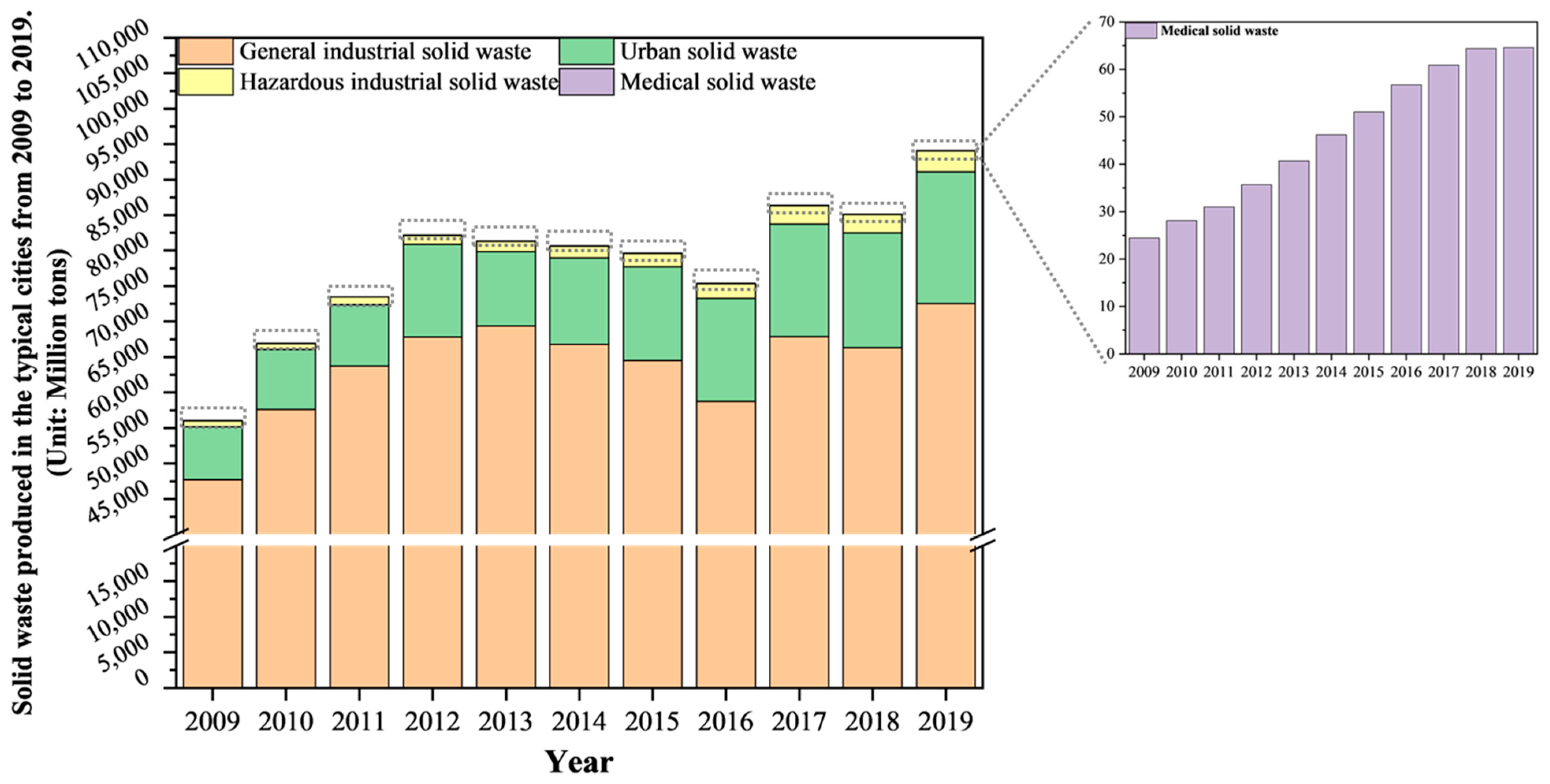
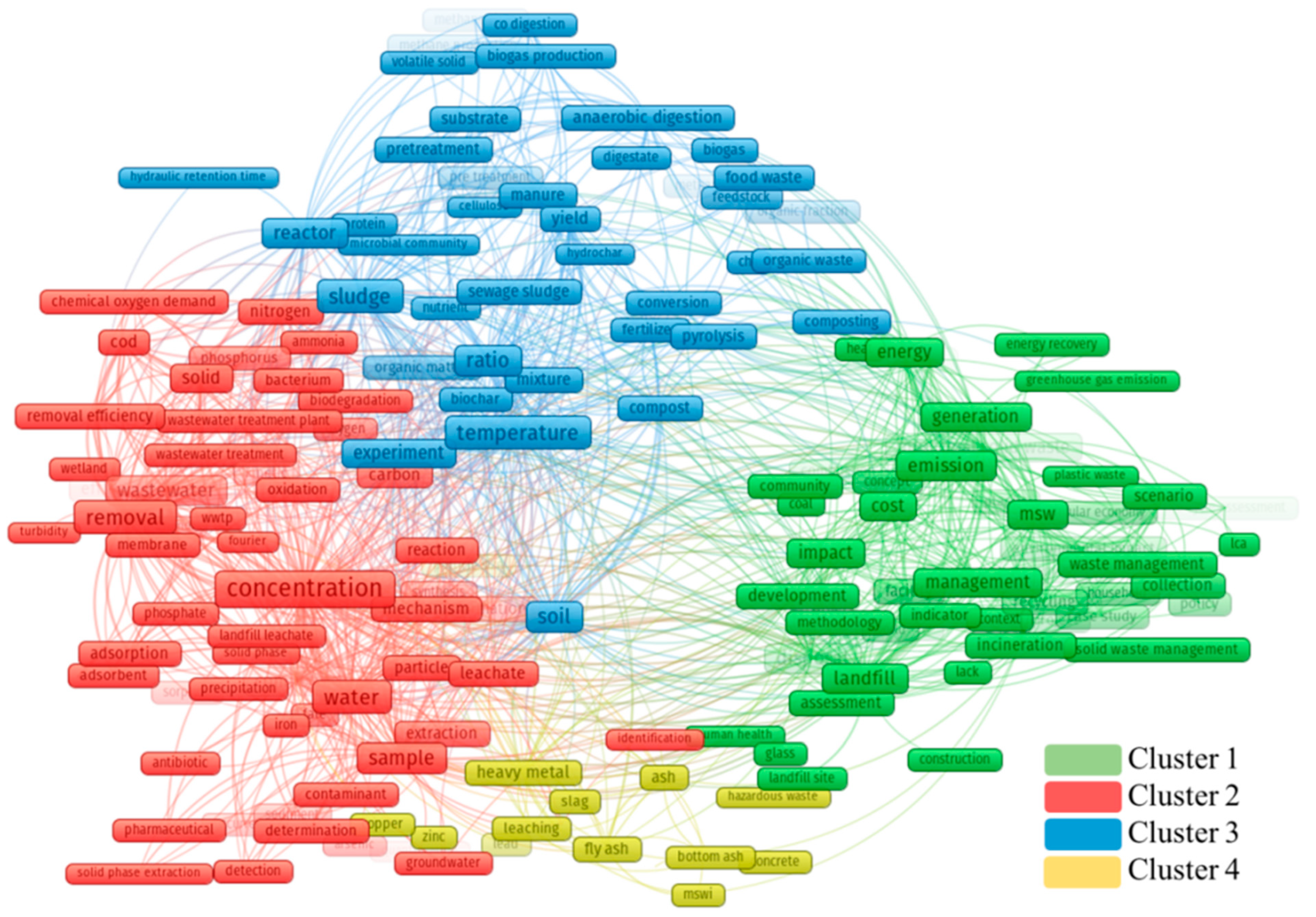

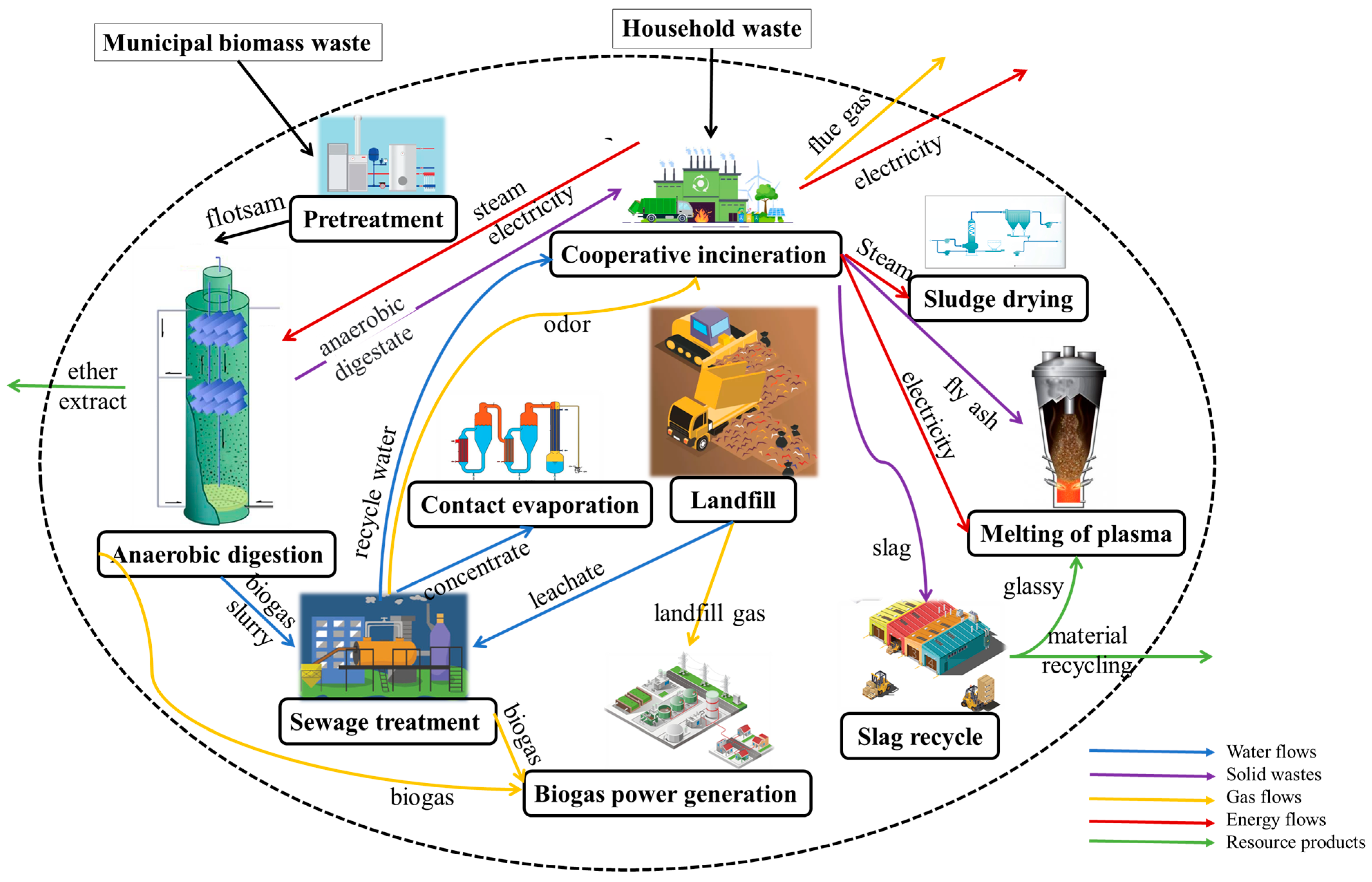

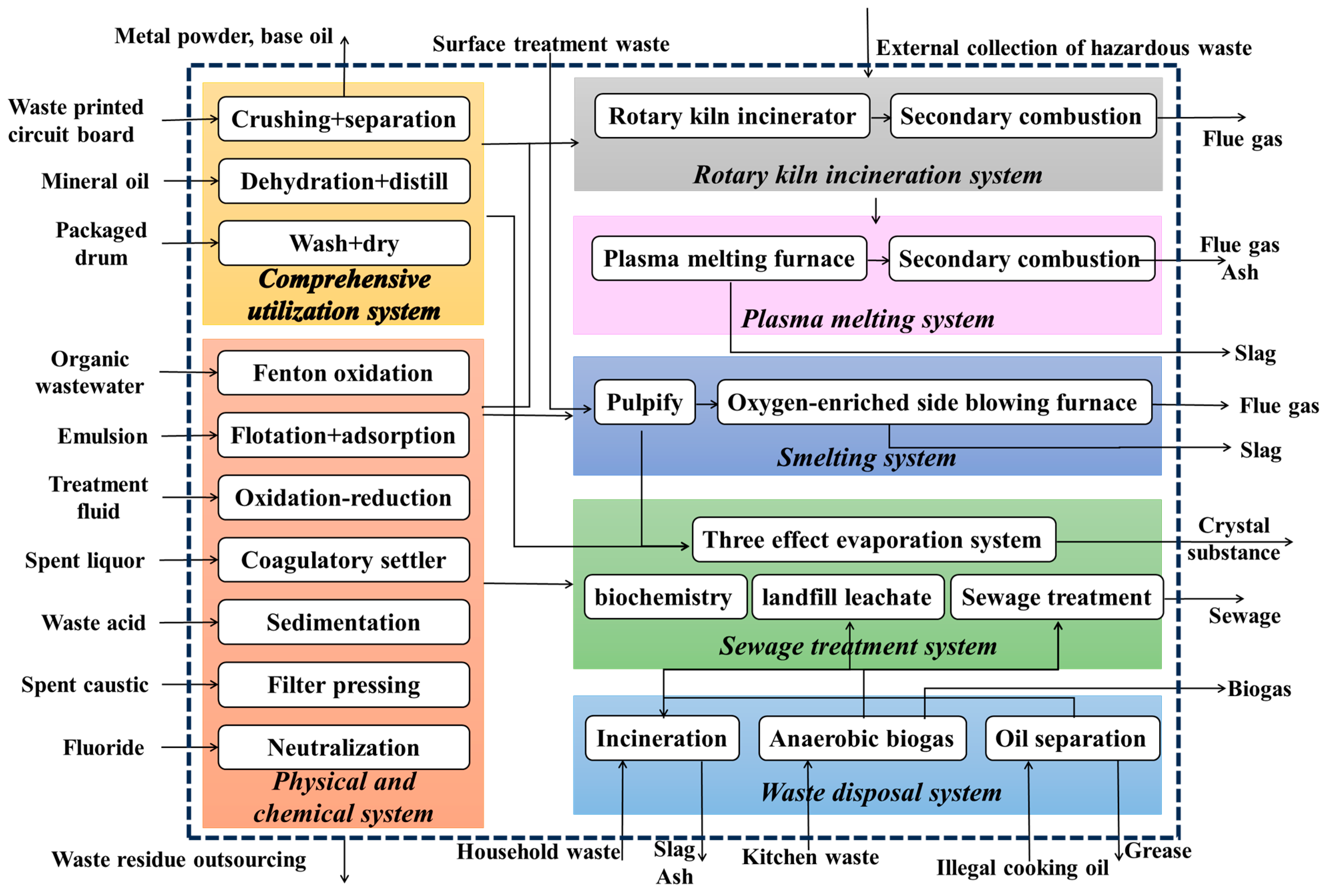
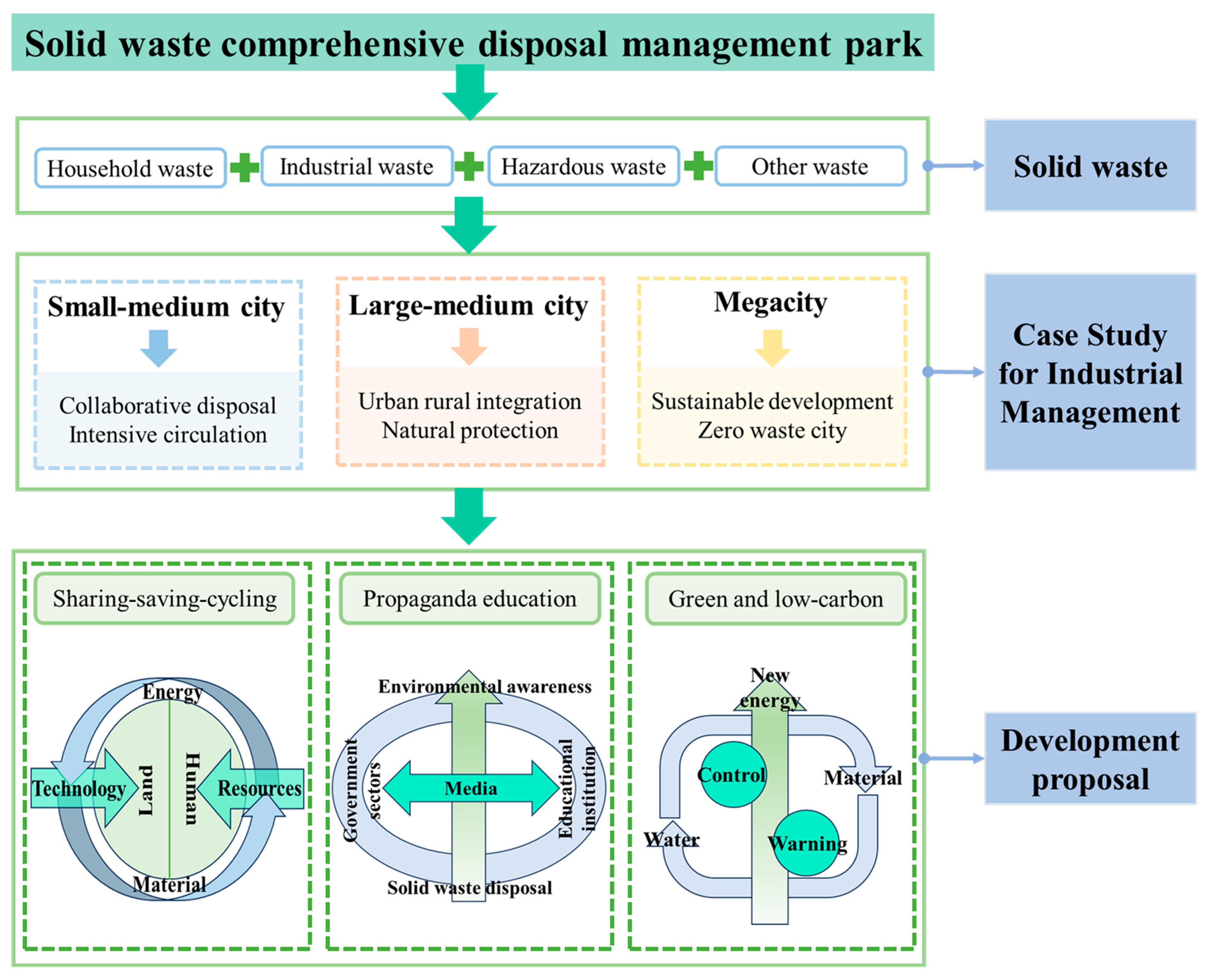
Disclaimer/Publisher’s Note: The statements, opinions and data contained in all publications are solely those of the individual author(s) and contributor(s) and not of MDPI and/or the editor(s). MDPI and/or the editor(s) disclaim responsibility for any injury to people or property resulting from any ideas, methods, instructions or products referred to in the content. |
© 2024 by the authors. Licensee MDPI, Basel, Switzerland. This article is an open access article distributed under the terms and conditions of the Creative Commons Attribution (CC BY) license (https://creativecommons.org/licenses/by/4.0/).
Share and Cite
Yu, L.; Chen, S.; Tan, Z. Analysis of Solid Waste Treatment and Management in Typical Chinese Industrial Parks with the Goal of Sustainable Development and Future Suggestions. Sustainability 2024, 16, 6731. https://doi.org/10.3390/su16166731
Yu L, Chen S, Tan Z. Analysis of Solid Waste Treatment and Management in Typical Chinese Industrial Parks with the Goal of Sustainable Development and Future Suggestions. Sustainability. 2024; 16(16):6731. https://doi.org/10.3390/su16166731
Chicago/Turabian StyleYu, Lu, Sichen Chen, and Zhe Tan. 2024. "Analysis of Solid Waste Treatment and Management in Typical Chinese Industrial Parks with the Goal of Sustainable Development and Future Suggestions" Sustainability 16, no. 16: 6731. https://doi.org/10.3390/su16166731
APA StyleYu, L., Chen, S., & Tan, Z. (2024). Analysis of Solid Waste Treatment and Management in Typical Chinese Industrial Parks with the Goal of Sustainable Development and Future Suggestions. Sustainability, 16(16), 6731. https://doi.org/10.3390/su16166731





